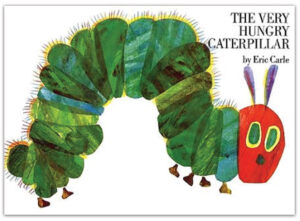Receptive language, Expressive language
Toddlers participate in a book sharing about a hungry caterpillar.



 [Invite several toddlers to join you to read a story about a hungry caterpillar. Greet toddlers by name.]
[Invite several toddlers to join you to read a story about a hungry caterpillar. Greet toddlers by name.]
Our book is about an animal called a caterpillar. The caterpillar in our book is very hungry. He eats and eats until he gets big! Our book is about all the different foods he eats. After the caterpillar eats all the food, something special happens to him!
[Show book cover. Point to the caterpillar.]
Here is the very hungry caterpillar. What do we think he is going to eat?
[Pause for and acknowledge toddlers’ responses.]
Let’s read our book and find out what happens to the hungry caterpillar in our story!
[Use the following strategies to engage toddlers in the book:
Our book told us about a tiny caterpillar who was very hungry. He ate lots of different foods. The caterpillar grew big! He made a small house around him called a cocoon. What happened to the caterpillar when he came out of his cocoon?
Some toddlers will be familiar with this book but are likely to again enjoy hearing the story of a unique animal and looking at the bold illustrations. What happens to the caterpillar at the end of the story is an exciting development that you can enhance with enthusiastic reading. This book includes counting food items, but counting is not expected at this stage of development. Approach the book sharing as a language experience that helps toddlers strengthen their awareness of food names.
Extra support
Enrichment
Receptive language, Expressive language
Toddlers participate in a book sharing that focuses on names of food items, including “feeding” food items to a pretend caterpillar.



Be Prepared: Secure toy food items that correspond to foods described in the book. The container is a pretend caterpillar. You may wish to use a large round container covered with green construction paper.
 Use strategies suggested in Option 1 to share the book with toddlers. After the story, introduce the toy food items and container. Explain that the container is a pretend caterpillar. Place the food items on a low table or floor in front of toddlers. We are going to feed the caterpillar!
Use strategies suggested in Option 1 to share the book with toddlers. After the story, introduce the toy food items and container. Explain that the container is a pretend caterpillar. Place the food items on a low table or floor in front of toddlers. We are going to feed the caterpillar!
Invite each toddler, one at a time, to pick a food item to “feed” the caterpillar. Say the name of the food item and encourage toddlers to repeat the name with you. Example: “Martin picked a pear. Let’s say the word pear together. Martin is feeding the caterpillar a pear. Yum. I think the caterpillar likes eating the pear!” Alternatively, if you anticipate the toddler knows the name of the food item, invite him/her to say the name and then encourage toddlers to repeat the name. Ensure each toddler gets at least one turn. Conclude the activity with a brief summary of what happened. Example: “Each of us fed some food to the hungry caterpillar. Look at the food our hungry caterpillar ate! Now our caterpillar can grow bigger!”
Focusing on the names of food items can strengthen toddlers’ vocabulary and general understanding that each item has a specific name. In general, toddlers are not expected to know or be able to say the names of the food items independently, although some toddlers may know the name of the item they selected, as suggested in the activity description. Instead of repeating a food name with you, some toddlers may offer a related response, such as saying the word “yummy” or making a face that communicates dislike. Most toddlers will enjoy feeding the caterpillar. Some toddlers may prefer to hold a food item and watch the activity. Acknowledge different types of participation. Example: “You are holding an orange, Joaquin. Would you like me to feed the orange to the caterpillar, or would you like to hold it?”
Extra support
Enrichment
Materials Needed: The Very Hungry Caterpillar by Eric Carle, toy food items, and container used in Option 2
Place the book, toy food items, and container on a low table so toddlers can repeat or expand the Option 2 activity. Emphasize the concepts of in and out as toddlers put food items in the container and take them out by dumping the container or removing one item at a time. Provide a container for each toddler to use as a pretend caterpillar.
Materials Needed: The Very Hungry Caterpillar by Eric Carle, large sheet of paper taped to a low table, assortment of age-appropriate crayons and markers
Involve all children in the book sharing. Older children can count the fruit as you read the story. Younger children can point to named food items. Infants can hold and manipulate a toy food item during the activity. After the book sharing, invite toddlers and older children to draw pictures of foods they have eaten that are featured in the book. Offer to write their words near their pictures.